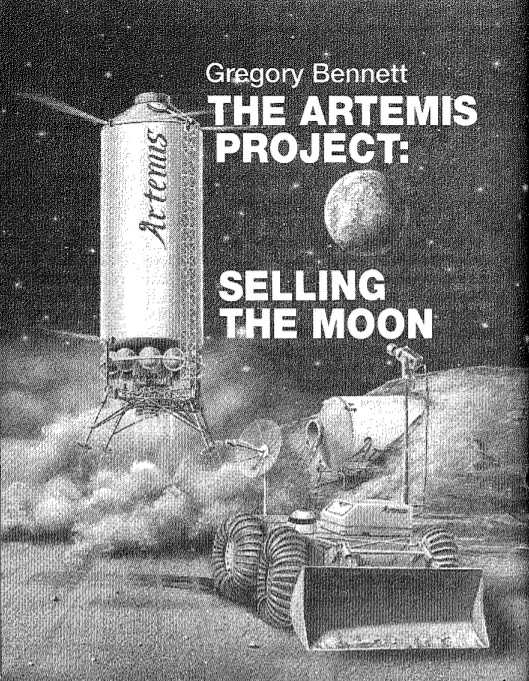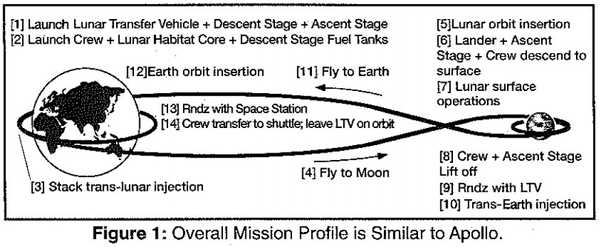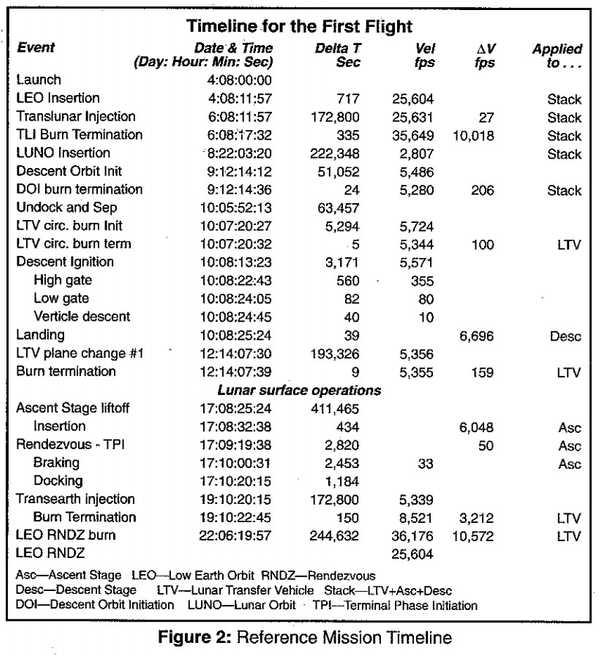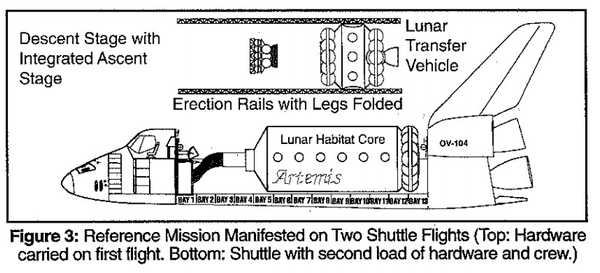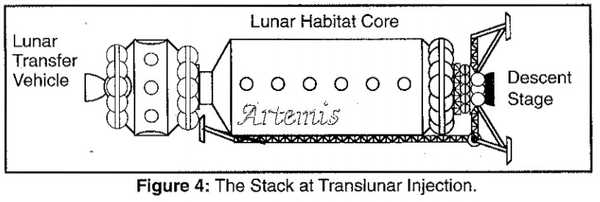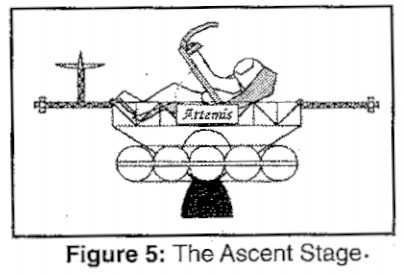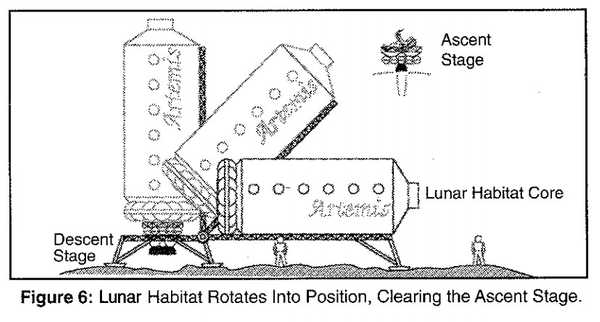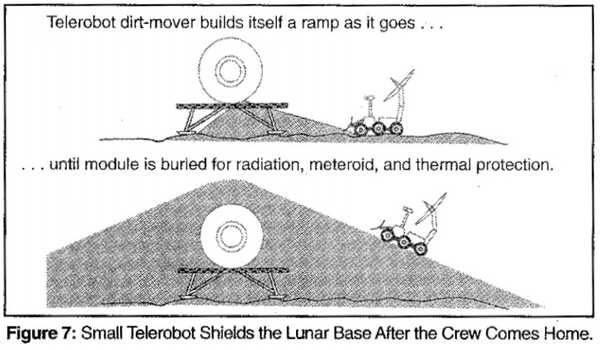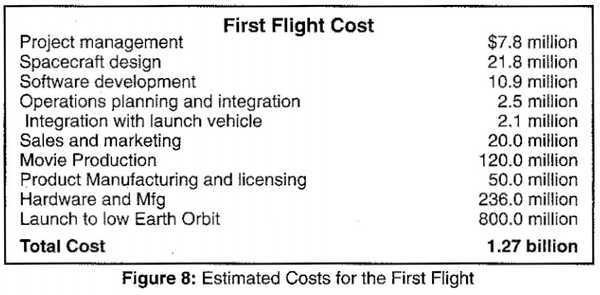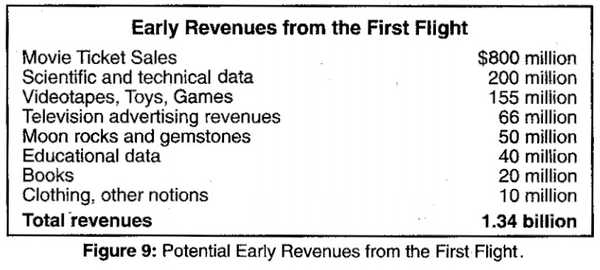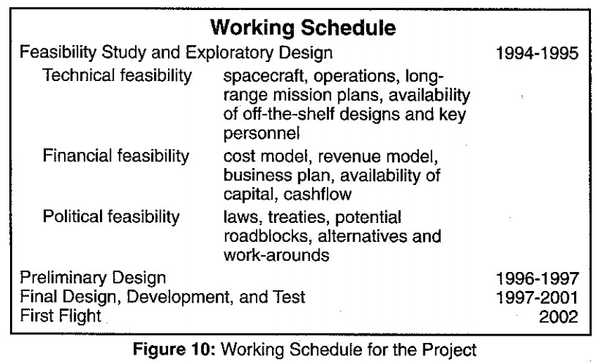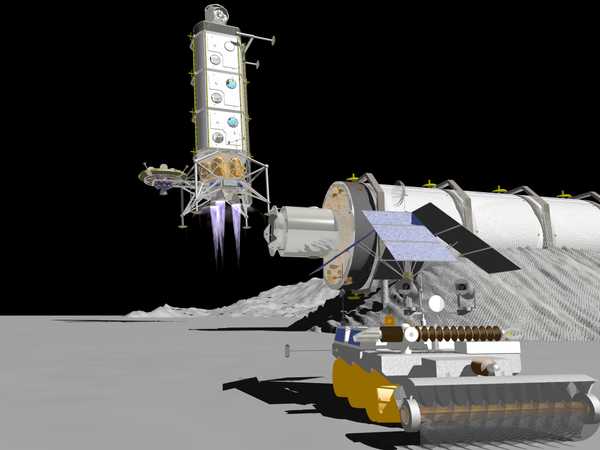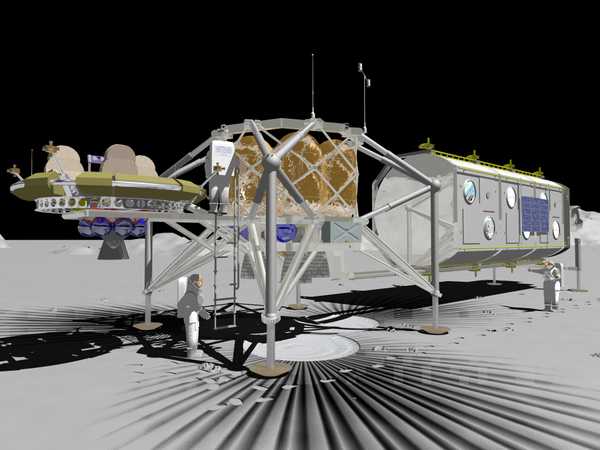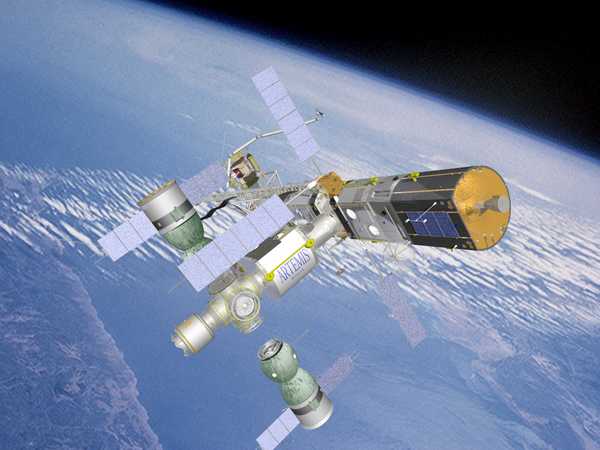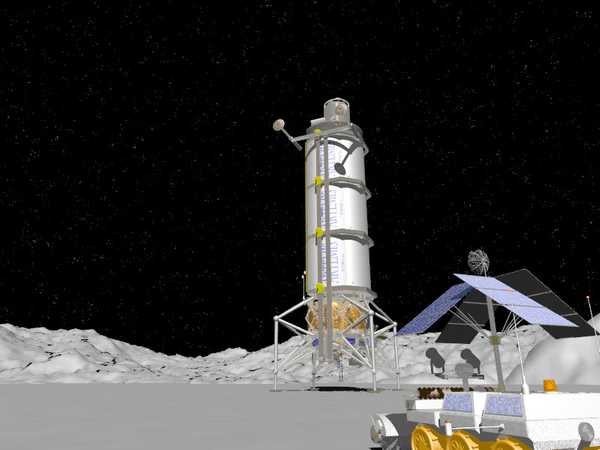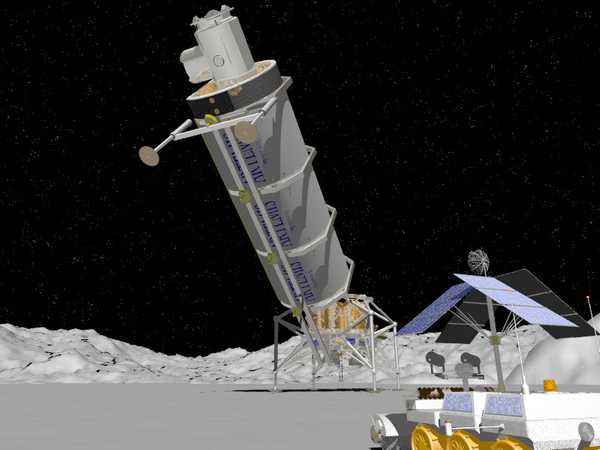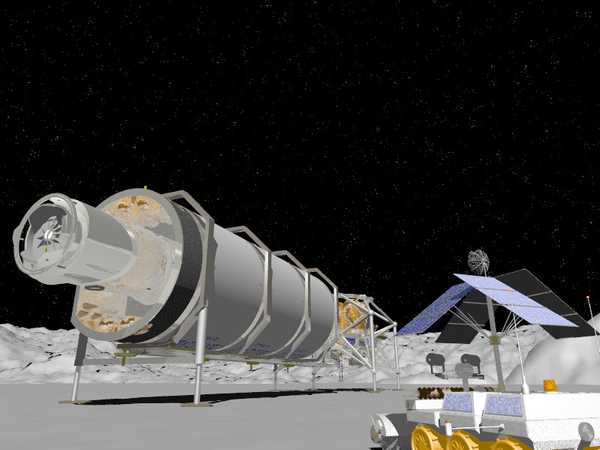The Artemis Project: Selling the Moon
This is the original magazine article describing the Artemis Project, a plan developed in the 1990s for a commercial moon base as well as a description of the mission architecture and funding methods for the project. It has never before been published on the Internet.
Reference the bottom of this article for additional new renderings created in April 2020.
Originally Published in Analog Magazine - January 1995.
Republished April 2020 with permission of the author and of Analog Magazine.
The Artemis Project: Selling the Moon
By Gregory Bennett
"Who do you think you are? D. D. Harriman?"
"Nope. Harriman had it easy," I said. "More like P. T. Barnum!"
That verbal melee took place in a hotel hallway at Norwescon 17, just after the debut presentation of The Artemis Project.1 D. D. Harriman, the title character in Robert A. Heinlein’s classic science fiction story "The Man Who Sold the Moon," used overt salesmanship to talk a reluctant board. of directors into financing the first flight to the Moon. In the story, Harriman had his share of challenges, but the obstacles Heinlein imagined are a mere shadow of those confronting private space ventures in the late twentieth century. But there is a way. We can get to the Moon the way P. T. Barnum would do it -- with The Greatest Show on Earth. Or Elsewhere.
For twenty-five years we've tried to find a way to get back to the Moon. Hundreds of studies have developed elaborate plans for lunar bases and transportation systems. Space activists are working to strike down laws that stand in the way. Hopeful enthusiasts have examined the economics and come up with schemes for exploiting lunar resources to make a lunar base pay for itself in the long run. But all those plans have been blocked by the same harsh reality -- there’s no way to get started. The size of the initial investment needed for a lunar base coupled with the time investors have to wait to see a profit defies all attempts to develop a serious business plan.
Any successful space venture must overcome three major obstacles: technical, political, and financial. We jumped the technical hurdle long ago. With Apollo, the U. S. taxpayers bought the tools to prove it could be done, with the Shuttle they proved reusable spacecraft would work, and today the space station program is putting the finishing touches on the systems people need to live in a space environment. Thousands of space enthusiasts are working on the political hurdles, finding laws that inhibit private enterprise from going into space and working to change them. Politicians are driven by public opinion, and if enough people become interested in having private enterprise get into manned space flight, efforts to change the laws will succeed.
But the financial problem has remained unsolved until now.
Recent history abounds with proposals for development of extraterrestrial resources, each promising fantastic profit in the long run. When we started the first local chapter of the L5 Society in Seattle back in 1976, I took the show on the road in 100 public lectures during the next two years. The story then was solar power satellites, huge orbiting space colonies to build and maintain them, and a lunar mining facility to provide the raw materials. The books appeared to balance at around $30 billion, and after that the profit would come rolling in; but there was fatal flaw. Half a human lifetime lay between the initial investment and the break-even point. Private enterprise is just not set up to wait that long to realize a profit on an unknown venture. For a while we thought perhaps life insurance companies would go for it, but their long-term investments are locked up in safe, reliable securities rather than wildcatting adventures in space.
Even a government used to spending billions of dollars the way most of us buy soda pop, was unable to cope with the duration of the project. "Not one penny for this nutty fantasy!" declared Senator William Proxmire. It soon became clear that balancing the books some time in the far-distant future was not going to work. A whole new approach was needed, and none was forthcoming. Its members discouraged, the L5 Society degenerated from a project-oriented movement to a political lobbying organization with no specific goals.
The governments of all the world’s leading industrial nations have managed to bankrupt themselves. There’s no point looking to them for leadership in space; they can’t afford it. It would seem that, despite the longrange promise of developing the Moon, it’s impossible to take that critical step.
The world has changed since "The Man Who Sold the Moon" was published. With the Apollo program, we solved the technical problems and proved it can be done, but because of Apollo our only model for space flight is the incredibly high costs of government-sponsored manned space programs. A host of laws and treaties stand in our way, each seemingly designed to keep private enterprise out of the space business, and the government regulations to be dealt with make a stack higher than a Saturn V rocket.
Fortunately, today’s world also provides us with the means to solve those problems -- the economic and political power of the entertainment industry. We can develop the political clout necessary to change most of those laws and pay for the initial development of a lunar base with its entertainment value.
Very few Analog readers need to be lectured on the promise of extraterrestrial resources and the strategic importance of the Moon in developing them. To the average citizen, though, everything we have done in space, from the meticulous glory of the Apollo program to the wondrous images Voyager sent back from the gas giants, is little more than just another form of entertainment. It’s Monday night football, Friday night happy hour, and every night’s evening news and sitcoms. That is precisely why The Artemis Project will work.
The Artemis Project
The project began as a mental exercise. Over lunch and happy hours, we kept asking ourselves the same questions. Why don’t they go back to the Moon? Why is manned space flight so expensive? Why don’t they cut out the bureaucracy and get the costs down to a reasonable level? Why don’t they develop space by exploiting the resources available from the Moon? Why don’t they... ?
The answer to these questions always came back to the same thing: money. So we started digging into the money question, approaching the problem from both reducing the cost and where the revenues might come from. In less than a week, it started to come together.
"Enough with asking ‘Why don’t they?’" I said. "Why don’t we?"
That question defied an answer. So we did.
Thus, in 1993, the Artemis Project was born. Our analysis showed that a privately financed commercial venture could establish a permanent, manned lunar base and at least begin to exploit the resources of the Moon for future development of space travel. To make it work, we would have to minimize government involvement; it would be a 100% commercial venture, which means it would have to be privately financed. And it had to show a profit from the first flight to the Moon.
We talked with the experts in manned space flight, interviewed managers whose experience dates back to the Mercury and Gemini programs, and dug into the potential income from such a venture. The deeper we dug, the better things looked. Eventually we decided to continue on with the project until we discovered a fatal flaw in the plan. We did that public presentation at Norwescon as a trial balloon and received an overwhelmingly positive response. People experienced in investing in space ventures, albeit mundane ventures by comparison to a private Moon base, found out about the project and expressed their interest. In early 1994, when we still had not found a fatal flaw, we set up the Lunar Resources Company to bind the activity together. In the summer of 1994, when this article was written, we were working on turning the company into a public corporation, still looking for a reason to stop, still looking for that elusive fatal flaw.
We found it is easy to become distracted with the big picture and wind up spending all our time day-dreaming about what people will do with oxygen, aluminum, helium-3, and whatever else we might dig out of the Moon. To keep ourselves focused, we established four major goals for the project: (1) To establish a permanent manned base on the Moon. (2) To exploit lunar resources for profit. (3) To demonstrate that manned space flight is within the reach of private enterprise. (4) To bootstrap private industry into manned space flight. To focus the activity even further, we decided to concentrate on the first Artemis flight, which places a habitat on the Moon for permanent occupation.
Early in the project, we decided to go back to the tradition of using names from ancient mythology for manned space flight programs. Mercury, Gemini, and Apollo carried human beings to the Moon in less than ten years, but manned space programs lost sight of their exploratory nature and fell into lethargic bureaucracy when they adopted more pedestrian names like Skylab, the Space Shuttle, and the Space Station. We settled on the goddess Artemis as our namesake.
Artemis is the twin sister of Apollo in Greek mythology. She is the Moon, and Apollo is the Sun. Artemis is also the goddess of the hunt, a constant reminder that our project is a voyage of exploration, a venture which will live off the land in its travels and return products of great value to our home on Earth.
Reference Mission
To conduct a serious feasibility study, we needed a reference mission. It didn’t have to be elegant; it just had to work. That would give us enough to determine the mission costs and identify the obstacles. As long as financial, political, and legal obstacles can be overcome with the resources available to us, we haven’t found the fatal flaw we’re looking for. We plan to continue refining the reference mission and the business plan that goes with it until we find that flaw. Each step expands the resources available so we can get closer to establishing a lunar base. If we haven't found the flaw by the time we’re on the Moon, then we did it!
The reference mission is being used in the current feasibility study to determine costs, revenues, and technical and political issues. Right now weare looking at only the first flight. Like nearly every other study of lunar bases, the overall mission profile shown in figure 1 is similar to a typical Apollo lunar flight. This mission profile gave us the timeline and rocket burns listed in figure 2. This is a reference mission timeline, used for costing and feasibility studies only. In fact, the Moon is in the wrong place for the dates shown in July 2002, but the timeline is quite sufficient for the current study.
The trajectory and landing site are based on the Apollo 16 flight profile. Apollo 16 landed near Descartes Crater in April 1972. Unlike the Apollo flights, the reference mission profile assumes we loiter in Earth orbit for two days to stack and check out the vehicle at the start of the flight.
The first step is getting to low Earth orbit. We turned to existing launchers for our reference mission. As shown in figure 3, two Space Shuttle launches will be used to get the Artemis hardware into low Earth orbit, where the Moon vehicle will be assembled. Our crew goes up with the hardware on the second flight.
If the International Space Station is available and the launcher can deliver our spacecraft to it, we plan to use the space station as a staging base. If not, we will launch the first element on one flight and then rendezvous with it on the next flight. In that case our crew will use the Shuttle as a staging base for assembling the Artemis spacecraft.
The Space Shuttle was selected as the launcher for the reference mission because, although it is the most expensive launcher in the world today, it is also the most capable man-rated booster. Current development of new lower-cost launchers in the United States and abroad may change the situation before Artemis is ready to launch. Until then the Shuttle is the best vehicle which can satisfy all the Artemis mission demands. Also, we are being as conservative as we reasonably can in defining the reference mission. If the costs and revenues balance using the Space Shuttle, then they will look even better with a less expensive launcher.
There are three distinct spacecraft in the reference mission: the lunar transfer vehicle, the lunar base core module with its descent stage, and the ascent stage. Figure 4 shows how these vehicles stack up when we're ready to head for the Moon. The Lunar transfer vehicle is a small spaceborne habitat with propulsion systems and support for the crew during flight between Earth and Lunar orbits. The Descent Stage & Lunar Base Core Module consist of a propulsion package attached to the core module’s pressurized habitat. The Ascent Stage shown in figure 5 is folded up and hidden by the Descent Stage propulsion systems during the first half of the flight. It is a light weight, open vehicle (often referred to as "a rocket-powered hammock") to return the space-suited crew from the lunar surface to the orbiting lunar transfer vehicle.
These three spacecraft make up the stack which is flown to the Moon. After the stack is assembled at the space station, the lunar transfer vehicle’s rockets are used to fly to lunar orbit.
Upon arrival in lunar orbit, the lunar base core module with its descent rockets separates from the lunar transfer vehicle and lands on the surface of the Moon. While the crew is flying down in the Descent Stage, the Lunar Transfer Vehicle circularizes its orbit around the Moon at an altitude of 60 nautical miles. Advances in automation technology and guidance and control systems since the Apollo program will probably allow the Lunar Transfer Vehicle to remain unmanned during the surface operations. We are assuming automated guidance can handle the necessary orbit circularization and plane change without the need for a human on board. If so, we save the additional weight required to support an LTV pilot during the mission.
For controllability, the lunar base core module is oriented vertically until it reaches the lunar surface. On the Moon, the crew levels the lunar base core module as shown in figure 6 and reconfigures the lunar base for permanent operation. After landing vertically, the descent stack drops a foot at the end of a long truss to brace against, and then the core module rotates into position.
During their visit to the Moon, the crew conducts extravehicular activity to assay the site and gather samples of the lunar regolith (Moon dirt). They also set up cameras to get stock footage of the site and their activities, as well as to record their ascent and the arrival of the next fight. (They film activities throughout the flight, both stock footage and scripted scenes for later use in movies and documentaries. Remember, we're in show business here.) When surface activities are complete, the crew boards the ascent stage and makes the two-hour flight to rendezvous with the orbiting Lunar Transfer Vehicle.
The entire ascent is EVA, with the crew depending on their space suits for life support. The flight should pose no greater hazard to the crew than two hours of surface EVA. We expected seasoned astronauts to balk at this bit of derring-do, but so far the response has been overwhelmingly positive. The primary safety issue that has come up is that until the habitat module is rotated out of the way, the crew has no way to get home. We will address that issue when we get to more detailed design stages; this reference mission is sufficient for now to evaluate the feasibility of the project.
After docking the ascent stage to the Lunar Transfer Vehicle, the crew returns to Earth orbit. Unlike Apollo, they do not do a direct entry into Earth’s atmosphere. Instead, they expend more fuel to brake their trajectory and enter Earth orbit for a rendezvous with the space station.
Carrying fuel for the final braking to Earth orbit reduces the size of the base we can leave on the Moon, but there are several advantages which appear to outweigh that cost. By leaving the transportation system in orbit for use on later flights, we lower the cost of future development. It also cuts the cost of the initial flight by eliminating the need to develop a vehicle which can operate in the atmosphere, and trades the weight of the additional fuel for the weight of the heat shield we would need for atmospheric entry. An alternative to using rockets for braking to Earth orbit would be to use a heat shield as an aerobrake; however, aerobraking technology is still in the early development stages and the expenses of developing it are beyond the anticipated capital resources of the Artemis Project.
At the space station, the crew secures the LTV and ascent stage. The LTV may be used at the space station for additional laboratory space between flights, or it may be leased for other operations in Earth orbit. Among the proposals we have received is to fly the LTV on a mission to a Near-Earth Asteroid. With additional fuel tanks plus food and air for the crew, it could perform this mission with little modification. Once the Artemis vehicles have been secured, the crew returns to Earth on the next available Shuttle flight.
It is possible (but not necessary) to conduct the entire Moon flight in one Shuttle flight, with the crew flying the same orbiter up and then back down to Earth’s surface. This will be an advantage if the space station is not available to support the mission, but the close time constraints eat away at our probability of mission success.
The mission is not over once the crew goes home. To survive the cold, two-week-long lunar night, the Moon base will need a lot of insulation. By burying the core module in Moon dirt, we provide the necessary insulation as well as protection from radiation and meteroids. The telerobotic dirt mover (we didn’t want to call it an "earth mover") shown in figure 7 is included in the mission plan for this purpose. Since the lunar base can survive several lunar nights using just its heater, this machine does not need to be very large. We can take several months to lay a blanket over the habitat.
Our mission plan was well under way with this little telerobot when another company announced plans to deploy a small robotic rover on the Moon, paying for its cost primarily with its entertainment value. This may provide an opportunity for synergism between the two projects, since a cursory look shows that if we were to add a bit of dirt-moving equipment to their robot, it could do the job. This would add greatly to the entertainment value of the robotic rover and significantly reduce Artemis costs at the same time.
The robot may also be able to get camera footage of the Artemis stack’s initial descent to the lunar surface. If so, it will be first time any vehicle has been recorded landing on the Moon.
Costs
Previous Moon base studies have based their cost models on the performance of government projects and assumed revenues would come only after decades of development. The resulting high capital costs and long term before realizing any profit made it impossible for private enterprise to finance a manned space venture. There is a fundamental flaw to estimating program costs this way; historical cost data based from an exploratory program with an unlimited budget continue to plague space development. Artemis attacks the money issue at both ends; costs are controlled by being a 100% private enterprise venture, and financing becomes realistic because the project offers an immediate return for the investment.
People who move from private industry to government programs are usually amazed when they first realize how many people it takes to get something done. It can be quite a shock to come from the commercial world, where engineering problems are usually worked out by two or three people in an afternoon, to the world of big government programs where similar problems are debated endlessly in three-day-long working group meetings in rooms filled with as many as 200 people from all over the country. This problem seems to be rooted in the fact that government agencies like NASA are modelled after the folks who hold the purse strings, the U. S. Congress. The Congress is a body of lawyers, not engineers. They were trained to solve problems by holding huge meetings, adopting an adversarial position, and arguing endlessly for their own interests with little regard to logic.
Analysis of government-sponsored space projects2 shows that no more than 10% of the money, usually even less, is actually spent on developing and operating the spacecraft. The rest goes to the enormous support effort and inefficient organizations necessary to answer the changing whims of the U. S. Congress, support a large institutional bureaucracy with extensive fixed assets all over the world, and to adapt to the government's management-by-meetings philosophy. The government has recently shown that some of these extra costs can be trimmed, but most of the overhead is the inevitable nature of the way governments do business.
Private enterprise does not, and could not, work that way. By organizing as a private company, acquiring resources no sooner than necessary, using the project schedule as a working tool rather than becoming a slave to it, and refusing to allow the project to lose sight of its goals in favor of implementing some politician’s social agenda, the costs of any program can be reduced by a factor of ten or more. Additionally, Artemis reduces its costs by using technology and resources already developed in previous manned spaceflight programs.
To develop a detailed cost model for the lunar base, we began by analyzing the work breakdown structure required to accomplish the project. After several discussions with engineers and managers currently working on manned space flight projects we reached agreement on just how much time was needed to do each piece of the job. Then we doubled the man hours to account for unknowns. A more typical visibility factor -- the amount added to account for the surprises lurking in the dark corners of a task -- is 15%, but frankly we chickened out. The numbers looked so much lower than our previous experience we assumed we must be overlooking something big.
Pennywisdom is another money-waster in government programs. Usually design engineers are hampered by a short supply of the machines and support personnel they need to do their work, so they spend a great deal of their time waiting for the resources they need. We want our people to spend their time in productive work, not in the frustration of waiting to get on a computer while deadlines loom over them. Machines are cheap these days; they should wait for the people, not vice versa. To eliminate this hidden cost, we applied a burdened labor rate half again higher than industry standards for aerospace engineering on government projects. Because of the high visibility factor and burdened labor rate, the costs shown in figure 8 are probably quite conservative.
This level of investment is quite common in the business world. For example, one new deep-water oil rig typically costs about one billion doilars.
Revenues
Artemis will pay for its initial development by exploiting the entertainment value of the first flights. This is not as unreasonable as it sounds; as I said earlier, to the average citizen manned space flight is little more than a form of entertainment, and the economic power of the entertainment industry is enormously greater than all aerospace endeavors combined. For example, a single major motion picture like Star Wars or Jurassic Park will gross more than a billion doliars in its first year, with about half the revenue coming from tickets sold at the box office. An often-quoted statistic from the halcyon days of Apollo is that the total money paid for television advertising during coverage of the early manned space flights exceeded the cost of the program, at a time when NASA was spending as high as 4% of total federal outlays. (Today, about one half of one percent of the federal budget goes to NASA’s space flight programs.)
This is why the first mission must be manned. The entertainment value of a robotic flight is not sufficient to pay the bills for the lunar base, and that first flight must capitalize on the advance marketing. Imagine a science fiction story in which there were no characters, not even an artificial intelligence; just unthinking hardware. Such a story might be of interest to a few scientists who can wonder at the inner workings of the Universe, but for mass market appeal you have to have people in the picture. Chances are, once they’ve passed all the other hurdles, candidates for the Artemis crew will be selected as much for their stage presence as for anything else.
The estimated revenues from the first flight, listed in figure 9, are based on comparison to similar mass-marketing ventures which tie movies or television shows in with associated products. The Apollo program was run with engineering precision, its drama hidden by the need for a government agency to present an unflagging image of confidence to the world. In stark contrast, The Artemis Project is designed to be entertaining from the start. With half a dozen science fiction writers already working on the project, we think it is very likely we will attain that goal and still retain the project's major appeal which sets it apart from pure science fiction productions -- The Artemis Project is real. In short, we plan to pay for the initial stages of the project through shameless commercialism.
Again, estimated revenues are somewhat conservative. This is the immediate return; it docs not include the profit to be made in the long run by exploiting lunar resources.
Other Space Development and Artemis
While it is possible to develop the Artemis space vehicles and conduct the reference mission scenario without it, the International Space Station program adds significantly to our chances of success. There are several reasons for this.
Without a space station, it is extremely unlikely that low-cost, man-rated launchers will be developed any time in the near future; there is simply no market demand sufficient to warrant the investment. Also, to keep development costs down the Artemis Project vehicles and Moon base are based on using designs and technology developed for the International Space Station Program. Elements of the space station’s habitats, power, cooling, communications, propulsion, and thermal control systemsare all directly applicable to the Artemis Project with little or no modification.
Finally, the basic mission scenario calls for using the space station as a staging base for the flight to Moon, and using the station as an orbiting base for the Lunar Transfer Vehicle between flights. We could do the mission during a single Shuttle flight, with the Shuttle loitering in low Earth orbit while Artemis flies to the Moon and back; but the time windows are very tight. A space station allows the Artemis hardware to be assembled and checked out in low Earth orbit where it can wait for replacement hardware to arrive if need be.
A new way of getting to low Earth orbit could also have a dramatic effect on the bottom line for The Artemis Project. The reference mission is based on use of the Space Shuttle for access to low Earth orbit, but many new launchers currently under development promise to dramatically lower launch costs. This in turn increases our chances of success with the project. New launchers couid increase the initial profit margin to stunning proportions both by lowering launch costs and increasing the project's entertainment value.
Schedule
The final feature in the Artemis Project story is its schedule. We want to get on with development of extraterrestrial resources as quickly as we can, but we are not in a hurry. As a commercial enterprise, the project can wait when necessary for the needed resources to become available; it does not have the threat of being cancelled by an impatient Congress or the embarrassment of headlines proclaiming that the project is late.
The project needed a working schedule to keep things on track. The dates listed in figure 10 assume no major political roadblocks are encountered along the way and the financing becomes available without a snag. A working schedule is a useful tool for managing a project, but we should emphasize that this is a working schedule, not an object of worship. Most space flight programs, by arbitrarily adhering to a schedule advertised to the Congress and the public, drive up their costs when one area falls behind while the rest of the team waits for them to catch up. The idle functions of the team usually spend their time institutionalizing procedures and paperwork, establishing new bureaucracies that never go away. A commercial endeavor with all its people working for the same organization can eliminate this schedule-driven cost growth by freely moving resources to where they are needed most and adjusting schedule milestones to synch up with the realities of the program.
Digging Deeper
Right now the project is in the viewgraph engineering stage. We're conducting the feasibility study, investigating the costs, legal problems, and financial and political challenges in ever-increasing detail. As we look closer, the technical and cost pictures get better, and the political challenges get worse. We have not yet found an insurmountable problem, but we are still looking for that elusive fatal flaw in the plan. If we don’t find it in the next few years, look for us on the Moon. And in your local theater.
About the Author
After seven years in design of commercial jet aircraft, Gregory Bennett moved to the Johnson Space Center where he has worked in manned space flight engineering for the past fifteen years. He currently works for a NASA contractor in extravehicular activity development on the International Space Station Program. No stranger to space industrialization, Bennett founded the first local chapter of the L5 Society in Seattle in 1976. That same year he founded the Northwest Science Fiction Society. His novelette "Tinker’s Spectacles" appeared in the June 93 Analog, followed by "Swan Song" in August. His novella "The Last Plague" was our cover feature in the April 94 issue.
FOOTNOTES
- Don’t confuse the Artemis Project with NASA’s Common Lunar Lander study. After the Artemis Project got its name, we discovered a group at the Johnson Space Center was using the name "Artemis" for a vehicle designed to land a small (less than 200 kg) robotic payload on the lunar surface. NASA dropped funding for the Common Lunar Lander in 1993.
- Bennett, Dyson, et al. Analysis based on examination of organizational behavior from 1989 to 1993 in development of space shuttle payloads, space station systems, and management of the U.S. space program. Presented at Norwescon 47, April 1994.
NEW RENDERINGS (April 2020)
The following are new renderings created by Vik Oliver in April 2020, from the original Povray models that were made in 1994 as part of the engineering design of the mission. You can hover over each image for a short description.
